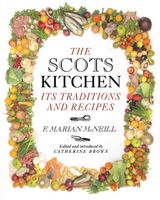Advertisement
Bannocks, Scones, and Teabread
Appears in
Published 2015

The process of bread-making is basically the same in all countries and in all ages, but there are many variations in the final stage of the dough. In Scotland these have always been particularly numerous.
The bread de luxe was Mayne bread, which was made with the finest stone flour. It is mentioned in 1443, when, according to the Edinburgh records, it was decreed that it should be made only on ‘Whitsunday, Sanct Geillis Mass (St. Giles Day, September 1), Yule and Pasch’. It appears to have been a rich kind of tea loaf containing sugar, butter, eggs and currants, which, as ‘raysins of Corinth’ were already imported in the fifteenth century. (It was also popular in England. Chaucer in one of his poems uses the simile, ‘white as paine de maine’, which suggests a French origin.)

